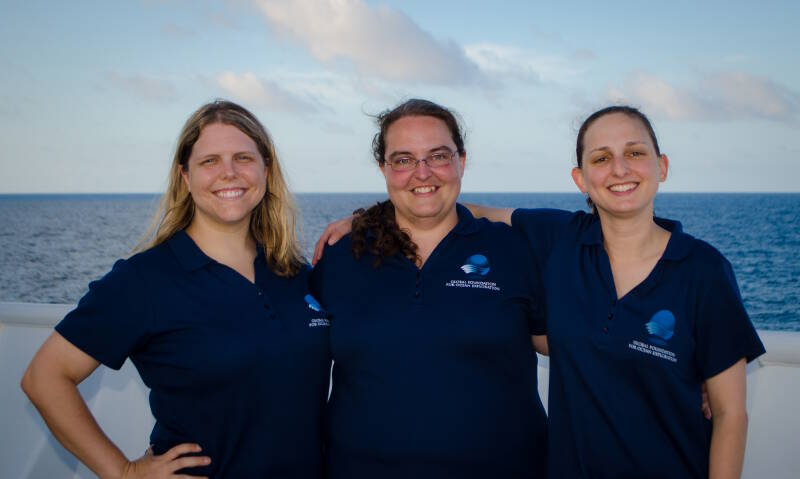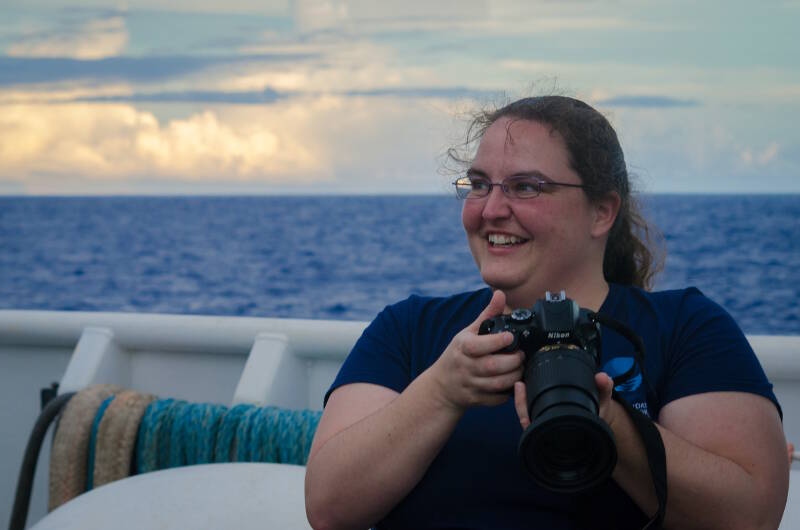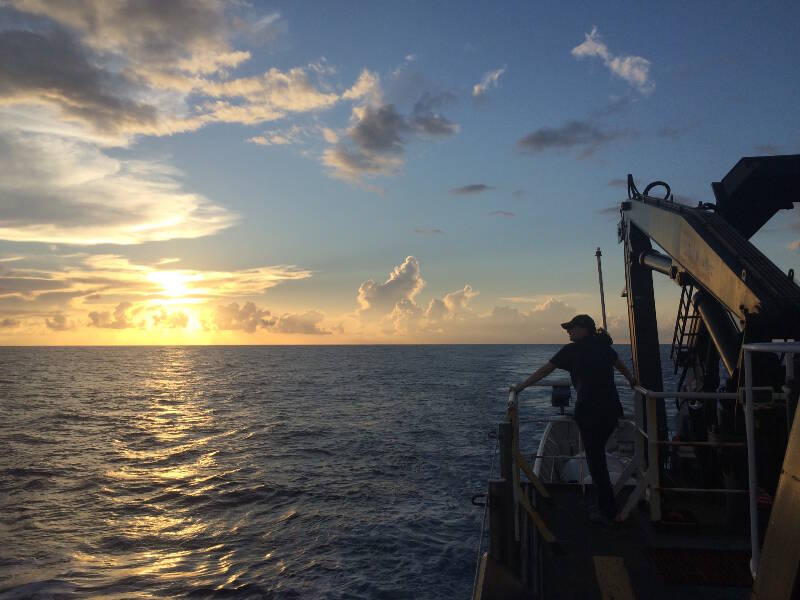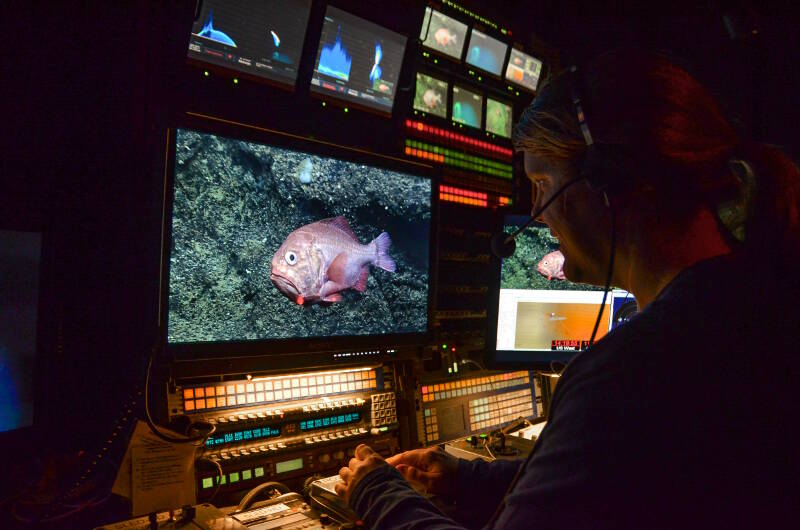
By Adrienne Copeland - NOAA Office of Ocean Exploration and Research
March 27, 2017

The women behind the highlight reels, Caitlin Bailey, Annie White, and Emily Narrow, onboard NOAA Ship Okeanos Explorer. Image courtesy of the NOAA Office of Ocean Exploration and Research, Discovering the Deep: Exploring Remote Pacific MPAs. Download larger version (jpg, 4.4 MB).
You might not know these women, but if you have seen the videos of the cosmic jellyfish, swimming dumbo octopus, or the siphonophore at depth, you know their work. They are famous for bringing the amazing vibrant images of the deep sea to life to you at home and picking songs that evoke emotions and match the clips perfectly.
To further celebrate National Women’s History Month on NOAA Ship Okeanos Explorer, I had the opportunity to sit down with the three (female) videographers on the Discovering the Deep: Exploring Remote Pacific Marine Protected Areas expedition.
The women behind the reels are Annie White, Caitlin Bailey, and Emily Narrow, all working for the Global Foundation for Ocean Exploration.

Annie White is taking still photos of the crew and staff on the Okeanos Explorer while they go about their daily tasks. Image courtesy of the NOAA Office of Ocean Exploration and Research, Discovering the Deep: Exploring Remote Pacific MPAs. Download larger version (jpg, 7.7 MB).
Q: How many Okeanos expeditions have you participated on?
Annie: This is my fourth expedition.
Caitlin: This is my third.
Emily: This is my third, too.
Q: What is one important lesson you have learned from spending long periods of time at sea?
Annie: Probably the value of “work hard, play hard.” The rewards that come from doing this job and the beautiful places we get to go makes all the hard work and occasional frustrations worth it. Living on a ship, there are so many jobs and things going on that you can be pulled in many different directions. These expeditions have also been a huge learning experience for me because I didn’t know much of anything about the deep sea before starting on the Okeanos. I have always loved the ocean, but I didn’t have any idea that these creatures existed before coming out here. It was a huge learning curve, but amazing.
Caitlin: I learned to never bring anything new to sea -- no new shampoo, no new clothes. Just in case it doesn’t work out. And to always take time to watch the sunset or appreciate the location and where we are. It is such a unique environment and I appreciate all the things that make the Okeanos Explorer special.
Emily: One thing I learned when I first started is the importance of having a good attitude and being patient, especially on a ship where you live and work with people. It makes everything better and helps things succeed and go smoothly. It is awesome how everyone comes together and how hard everyone works. Everyone on board the Okeanos Explorer is incredibly talented and I am amazed at how well we all get along and how friendly everyone is.

Emily Narrow enjoying the sunset after finishing her highlight video for the day on board the Okeanos Explorer. Image courtesy of the NOAA Office of Ocean Exploration and Research, Discovering the Deep: Exploring Remote Pacific MPAs. Download larger version (jpg, 2.6 MB).
Q: In honor of National Women’s History Month, which female (either current or from history) have you found to be most inspiring for your career and why?
Emily: I’d have to say Jane Goodall. She wasn’t a filmmaker per se, but she was featured in many nature documentaries. She is a fantastic role model. When not a lot of women were given many field assignments, she got one with chimpanzees. She changed the way we viewed women in the field and the way we view chimpanzees and humans as a species. She is a personal heroine of mine.
Annie: I completely agree: Jane Goodall -- because she found a way to do what she loved before women were accepted into science. She wanted to do it and found a way. Her love comes across and is infectious for people. She isn’t afraid to be that passionate and committed to something.
Caitlin: The woman I’ve found the most inspiring is Dr. Sylvia Earle. Her “Deepness” is a very powerful and inspirational lady. She loves the ocean so much. She is a huge inspiration to me because she has dedicated her whole life to the wonders of this world. Also, I think for all three of us, Gianna Savoie, a remarkable film writer and producer (also known as “The Mountain Mermaid”), has been an inspiration and guiding light throughout our careers and across the ocean.

Caitlin Bailey is working in the shading chair on the Okeanos Explorer. From this chair, she can control the zoom, focus, and exposure of the remotely operated vehicle cameras. Image courtesy of the NOAA Office of Ocean Exploration and Research, Discovering the Deep: Exploring Remote Pacific MPAs. Download larger version (jpg, 13.5 MB).
Q: What led to you wanting to be a science videographer?
Caitlin: That is a long story. The short version is that I always wanted to work with animals. I’ve had a lot of experience with them: completing zoo internships, working with rehab animals, and working in the field and lab. But nothing felt right until I discovered the Science and Natural History Filmmaking graduate program at Montana State University. Being a videographer allows me to be creative and I get to learn about different fields of science and different kinds of animals. With filmmaking, I have been able to explore everything from space to bacteria - across the science spectrum. For me, science has turned into a passion instead of just a career.
Emily: I’ve always loved wildlife. Even from when I was a kid, there was no question whether or not my career would include wildlife. I used to make films as a hobby, but in college, I realized I could do it as a career. So I double-majored in biology and cinema studies. Doing this lets me indulge in both of my passions. Being a science filmmaker, I get the best of both worlds.
Annie: Before I got into film and video, I was a biologist, specializing in animal behavior. I studied wild wolves and lived with captive wolves. The most life changing experience was when I spent two years traveling around the country with ambassador wolves, bringing them into school rooms and museums, letting people meet them face-to-face. Seeing the look in people’s eyes in that moment they made a connection made me want to bring this experience to more people than the wolves could ever actually visit. Science filmmaking seemed like the way to bring the wonders to as many people as possible and hopefully inspire them to care about the natural world.
This dumbo octopus was observed resting on the seafloor before it took off, gliding through the water as if flying, propelled by the fins behind its eyes. Video courtesy of the NOAA Office of Ocean Exploration and Research, Discovering the Deep: Exploring Remote Pacific MPAs. Download (mp4, 31.0 MB).
Q: What is it like being a female videographer at sea?
Annie: As far as the crew and the people out here goes, I don’t feel like I get treated differently as a woman at all. We are all members of the same Okeanos team. It is funny though, when we get into a port and 40 guys climb off the ship with just us two or three girls. But being a videographer is incredible. Being able to be a part of the documentation and discovery of the life in the deep ocean is amazing. I was a scientist first and working on the Okeanos Explorer brings my two passions together. I love doing outreach and getting people excited about this stuff.
Emily: I honestly don’t know if I can say what it is like to be a “female” videographer because out here I am just treated as a videographer, which is how I feel it should be. As for doing film work while at sea, it is a lot of fun. Occasionally it can be a lot of pressure because of the added complexity of the dives being broadcasted live. The jobs I do on shore aren’t usually live broadcasts. I really enjoy this aspect, though, because it means that more people are immediately seeing your work.
Caitlin: I agree with Annie and Emily; I am not sure it is any different from a male videographer. Being at sea though is definitely different than doing work on land as a videographer because we have to deal with a vessel that is moving all the time. This can make getting footage and the perfect shot more difficult. I had to buy special gear that will allow me to walk around the ship and get that perfect shot.
On August 6, 2016, during a remotely operated vehicle dive off of Wake Island, we found our old friend the sea toad, who, after a short posing session, was on the move. Video courtesy of the NOAA Office of Ocean Exploration and Research, Deepwater Wonders of Wake. Download (mp4, 137.4 MB).
Q: What is your favorite animal or object you have seen on the Okeanos Explorer feeds so far?
Emily: Probably something I saw during the Wake Island expedition. It was a sea toad, a pink sea toad, which is actually a type of fish. I made a daily highlight video of it. It was the funniest looking fish. I could not believe that something like this even existed on Earth. Every time I see pictures of it, it makes me very happy.
Caitlin: All of them! If I had to pick one, though, one of my favorite moments was when we saw a chimaera on the Marianas expedition. I am a little biased though because it was my first time in the shading chair on the Okeanos Explorer and it was the first thing we saw. [The shading chair is where we control the zoom, focus, and exposure on the remotely operated vehicle cameras.] I had never seen one before and to see it so close on the screen was powerful and magical. I got to make a video about it and now it is a postcard they hand out on tours. But seeing a swimming holothurian also makes me happy.
Annie: That is a really tough question. The most eye-opening animal has probably been the sharks. I have always been terrified of sharks, but being able to see their behavior in their natural environment has made me more fascinated with them than terrified.
On March 10, 2017, the second dive of the expedition, two sixgill sharks are seen swimming together. Scientists were able to tell that the sharks were a male and female pair. Video courtesy of the NOAA Office of Ocean Exploration and Research, Discovering the Deep: Exploring Remote Pacific MPAs. Download (mp4, 16.4 MB).
Q: What is your favorite video you have made and why?
Annie: My favorite is the video “What is That?”. It’s probably not the best video I’ve made because it was only my second one on the Okeanos Explorer, and my sixth day ever on the ship, but I remember the scientists on board and on shore kept asking “What is that?!” It seemed like every time we turned around we saw something new. I think it is incredible that there are still mysteries in the deep ocean, even to scientists that have studied it their whole lives. They had to go through not just species, genus, and family, but through four different phyla to figure out what they were seeing. The sense of wonder and needing to explore was infectious. I loved making it and I loved the response I got from it. It is why I keep coming out here and doing this everyday.
Emily: My favorite video, besides the sea toad, was one I made during the last expedition. It was a hermit crab with an anemone on its back. I really liked it because there was a great mix of humor and knowledge. The best daily highlight videos are the ones that are both humorous and educational.
Caitlin: I have one video that is my favorite because of the song. I always get the song stuck in my head. It is a swimming holothurian [sea cucumber] video I made during the Marianas expedition that I set to classical-type music. I find it both beautiful and hilarious.
While exploring Ahyi Seamount during Dive 5 of the leg, we encountered a range of sessile organisms that made scientists exclaim, 'what is that?!' These included a benthic ctenophores, a rare anemone (possibly in the genus Alicia), and a sea slug (or nudibranch). A frequent topic among the science team during the dive was if these organisms had recently taken up residence in the area or if they had resided in this area prior to a documented eruption of the seamount in 2014. Video courtesy of the NOAA Office of Ocean Exploration and Research, 2016 Deepwater Exploration of the Marianas. Download (mp4, 146.7 MB).
Q: We get this question a lot: How do you pick the different music for your videos?
Emily: Before we come on the ship, we each download about 50 -100 songs from an online music repository that we have rights to. We try to find music we think will be useful; songs that are dramatic, humorous, and go with amazing imagery. Then we try to match a video with its perfect song. Occasionally, we can’t find what we are looking for. For my most recent video, I couldn’t exactly find what I was looking for so I went back online to find something. Sometimes it takes a long time to find the right song and sometimes I find it on the first try. Sometimes the first song is perfect for the video and it has to be the one I use.
Caitlin: First, I will start off with what kind of feeling I want to attach to what is on the screen; whether it is an animal, object, or an event. Sometimes it is very easy to find music. I feel like a matchmaker sometimes because every video has the perfect song and I get to find the one. When I find the perfect song, I get this feeling. I can’t put into words, though. It is an instinct.
Annie: Sometimes it just comes to me. Sometimes I will see a creature that comes across the screen and I will already have a song in my head. Other times I will have to go through every song in the catalog before picking one for the day. The song determines how I edit the whole rest of the piece. If the music isn’t there, then I don’t have a film.
This Chimaera was seen during Dive 8 at a site known as Northwest Guam Seamount. These ghostsharks or rabbitfish are most closely related to sharks and rays and are now known only from deep water. Video courtesy of the NOAA Office of Ocean Exploration and Research, 2016 Deepwater Exploration of the Marianas. Download (mp4, 33.7 MB).
Q: Another common question from the public: Do you enhance the colors or do you try to make them true to life?
Caitlin: During the dives, we white balance to the distance of the Deep Discoverer arm. Everything with that range is the true color. [Learn more about color correction in this mission log.] When I edit photos and video, I try my hardest to make the color the “true” color or what it would look like with less blue. I never add colors. That is a “no, no,” especially as a scientist.
Emily: For live broadcast and footage, we try to make the colors as true to life as possible. At the end of a dive, we export still images that are used by sciences and educators. We end up with several hundred photos per dive that are not altered in any way. Then we will pick fifteen of our favorite photos and make copies of them. On those fifteen photos, we will make additional visual changes for promotional materials. But we make sure the ones that go to scientists have not been altered at all.
Annie: The things we see in the deep sea are mind blowing on their own, so we don’t need to add any fake colors. That is why we color correct before each dive, so the public gets to see the real wonders of the deep. We will color correct the animals in the highlight videos but that is just to compensate for the way water affects the wavelengths of light that reach the camera lens at different distances.
On March 14, during the sixth dive of the expedition, this intact deepwater siphonophore was observed. Although they may appear to be a single organism, these giant siphonophores are actually comprised of a colony of individual hydrozoans, each specialized for different functions such as swimming, feeding, and reproduction. Video courtesy of the NOAA Office of Ocean Exploration and Research, Discovering the Deep: Exploring Remote Pacific MPAs. Download (mp4, 20.0 MB).
Q: So besides videoing the mysteries of the deep, what is your superpower while out at sea?
Caitlin: Knock on wood, I have never been sea sick. I think that is a very important superpower to have while on a ship.
Emily: Hmm, I am not sure what to say. I have been on three cruises and I am always on the top bunk of the bunk beds. I am too old for bunk beds but I can still climb to the top bunk in very rough seas and not break a hip [haha]. I guess that is my super power.
Annie: I think maybe mine is being the voice of reason. I don’t always succeed. I, myself, am a workaholic, but I try to remember to take a half hour off each day to watch the sunset. I try to be that voice for people around me. We are a family at the end of the day and have to watch out for each other. If I do that for them, then they do it for me. Like last night when I was up until midnight working on the Dive 13 highlight video, the night mapping team insisted I go to bed and come back tomorrow. We really try to take care of each other out here.
Check out some of the very interesting undersea creatures observed during our second dive at Titov Seamount, which started at the base of a steep, sedimented slope at ~ 1,200 meters depth. Video courtesy of the NOAA Office of Ocean Exploration and Research, Discovering the Deep: Exploring Remote Pacific MPAs. Download (mp4, 28.4 MB).
Q: Okay, now for the most important question: If you could be any sea creature, which would you be and why?
Caitlin: All of them… But if I had to pick one, it would probably be a leopard seal because they are majestic and a little frightening. I have such a deep respect for these pinnipeds. They are the most amazing apex predator. I have never seen them in the wild, but I have seen them on video. My life’s dream is to go to the Antarctic and video and photograph them.
Emily: Ooooh, man. So many things I would want to be. I think I would want to be a killer whale because they live in pods (groups), are known to be very intelligent, and they’re powerful and strong and graceful. Though being an octopus would be pretty cool, too, because you can change the color, pattern, and texture of your skin.
Annie: If I could be any creature, I’d be an albatross… that counts right? They live most of their lives over the ocean. They are so beautiful and graceful in the air and they get to explore the world’s far reaches. On a personal level, if there is a chance to find something new, I have to do it. I want to know what’s over the horizon. And just like them, I can also be rather clumsy on land. The idea of flying everywhere I go is just so freeing!